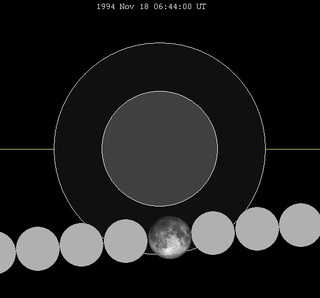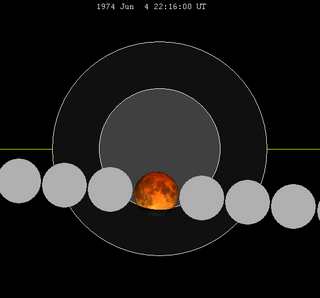
A partial lunar eclipse took place on Saturday, July 4, 1936.
Contents
This event followed the total solar eclipse of June 19, 1936.

A partial lunar eclipse took place on Saturday, July 4, 1936.
This event followed the total solar eclipse of June 19, 1936.
| Descending node | Ascending node | |||||
|---|---|---|---|---|---|---|
| Saros | Date Viewing | Type Chart | Saros | Date Viewing | Type Chart | |
| 103 | 1933 Feb 10  | Penumbral | 108 | 1933 Aug 05  | Penumbral | |
| 113 | 1934 Jan 30  | Partial | 118 | 1934 Jul 26  | Partial | |
| 123 | 1935 Jan 19  | Total | 128 | 1935 Jul 16  | Total | |
| 133 | 1936 Jan 08  | Total | 138 | 1936 Jul 04  | Partial | |
| 143 | 1936 Dec 28  | Penumbral | ||||
A lunar eclipse will be preceded and followed by solar eclipses by 9 years and 5.5 days (a half saros). [1] This lunar eclipse is related to two total solar eclipses of Solar Saros 145.
| June 29, 1927 | July 9, 1945 |
|---|---|
 |  |

A total lunar eclipse took place on May 4, 2004, the first of two total lunar eclipses in 2004, the second being on October 28, 2004.

A penumbral lunar eclipse took place on Sunday, December 30, 2001, the last of three lunar eclipses in 2001.

A total lunar eclipse took place on Friday 21 January 2000, the first of two total lunar eclipses in 2000.

A total lunar eclipse took place on Monday, November 29, 1993, the second of two total lunar eclipses in 1993, the first was on Friday, June 4.

A partial lunar eclipse took place on Wednesday, July 28, 1999, the second of two lunar eclipses in 1999.

A total lunar eclipse will take place on August 7, 2036. The southern tip of the moon will pass through the center of the Earth's shadow. This is the last central lunar eclipse of Saros cycle 129.
A total lunar eclipse took place on Saturday, May 4, 1985, the first of two total lunar eclipses in 1985, the second being on October 28, 1985.
A total lunar eclipse took place on Thursday, April 24, 1986, the first of two total lunar eclipses in 1986, the second being on October 17, 1986. The Moon was plunged into darkness for 1 hour, 3 minutes and 34.8 seconds, in a deep total eclipse which saw the Moon 20.217% of its diameter inside the Earth's umbral shadow. The visual effect of this depends on the state of the Earth's atmosphere, but the Moon may have been stained a deep red colour. The partial eclipse lasted for 3 hours, 18 minutes and 46.8 seconds in total. The Moon was just 1.2 days before perigee, making it 5.3% larger than average.

A partial lunar eclipse took place on Monday, August 6, 1990, the second of two lunar eclipses in 1990.

A penumbral lunar eclipse took place on Friday, November 18, 1994, the second of two lunar eclipses in 1994, the first was a partial lunar eclipse on Wednesday, May 25.
A penumbral lunar eclipse will take place on Monday, March 25, 2024. It will be visible to the naked eye as 95.57% of the Moon will be immersed in Earth's penumbral shadow.
A total lunar eclipse took place on Thursday, September 6, 1979, the second of two lunar eclipses in 1979. A shallow total eclipse saw the Moon in relative darkness for 44 minutes and 24.7 seconds. The Moon was 9.358% of its diameter into the Earth's umbral shadow, and should have been significantly darkened. The partial eclipse lasted for 3 hours, 11 minutes and 54.1 seconds in total.

A penumbral lunar eclipse will take place on May 7, 2031.
A partial lunar eclipse took place on Sunday, April 12, 1903. This nearly total lunar eclipse of Saros cycle 130 preceded the first total eclipse on April 22, 1921. The Moon was almost covered by the Earth's shadow in a very deep partial eclipse, which lasted 3 hours and 17 minutes. With 96.77% of the Moon in shadow at maximum eclipse, this was quite a memorable event.

A total lunar eclipse will take place on July 29, 2083. The Moon will be plunged into darkness for 1 hour and 30 minutes, in a deep total eclipse which will see the Moon 48.3% of its diameter inside the Earth's umbral shadow. The visual effect of this depends on the state of the Earth's atmosphere, but the Moon may be stained a deep red colour. The partial eclipse will last for 3 hours and 33 minutes in total.

A partial lunar eclipse took place on Tuesday, June 4, 1974, the first of two lunar eclipses in 1974.

A total lunar eclipse took place on Tuesday, January 19, 1954.

A total lunar eclipse will take place on September 19, 2043.

A total lunar eclipse will take place on October 30, 2050.

A total lunar eclipse took place on Wednesday, January 8, 1936. It was the second total lunar eclipse of Saros series 133.